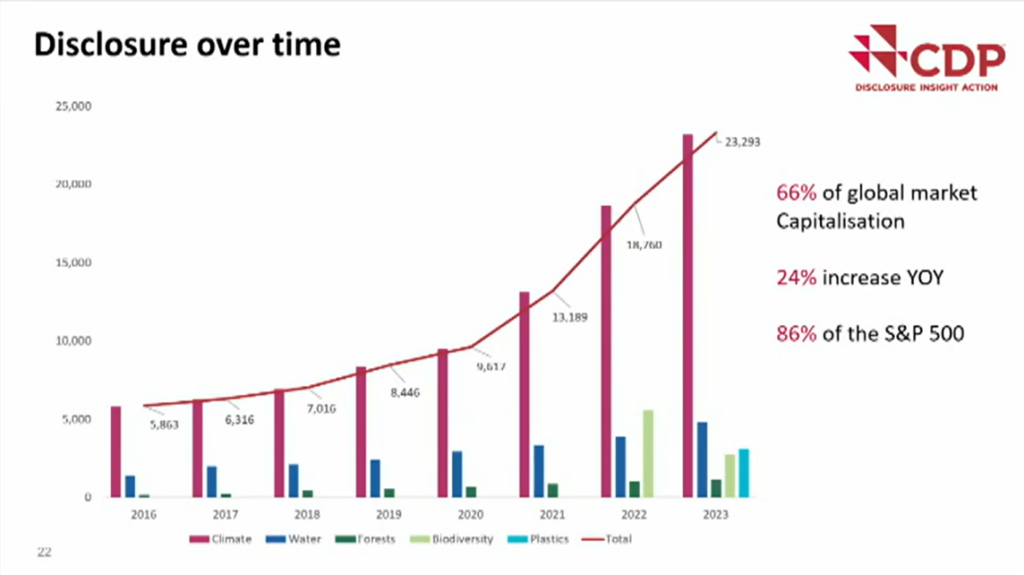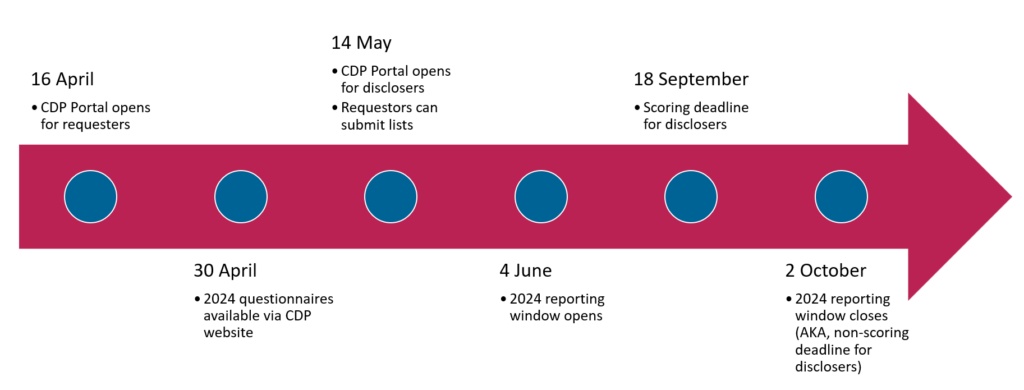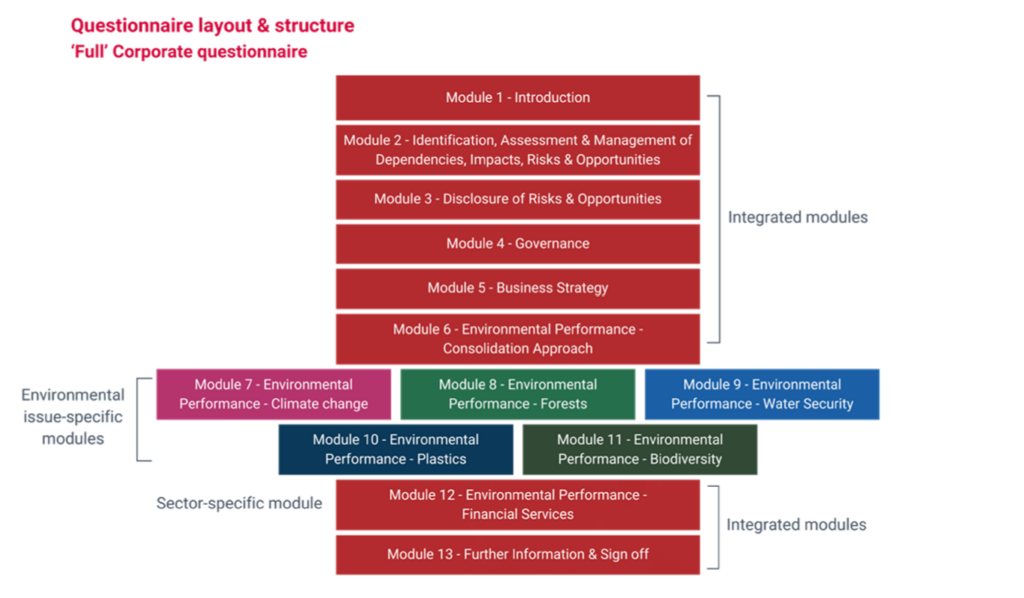CDP (formerly Carbon Disclosure Project) saw massive momentum in 2023 with a 24% increase in reporting companies that led to a record 23,200 companies representing over 66% of global market value along with 1,100 cities, states, and regions reporting to the standard last year.

Image courtesy of CDP Keynote at COP28 by CEO Sherry Madera
Climate change can impact businesses and municipalities in many unpredictable ways. Without disclosures, such as those from CDP, many stakeholders would be in the dark as to the risks municipalities and organizations face and how they contribute to the climate crisis directly or indirectly. More than 740 financial institutions representing over $136 trillion in assets request environmental information through CDP.
Even with the significant reporting entities growth, CDP still sees room for improvement.
Only one percent of companies reporting in 2023 disclosed details on all three CDP categories: climate change, water security, and forests. The needs for more comprehensive reporting, managing heightened disclosures volumes, and integrating newly released ESG standards like ISSB and TNFD have influenced CDP’s decision to make pivotal adjustments to the 2024 questionnaire.
Organizations looking to report to CDP this year will need to know about key changes, and why this may be a good time to consider resources purposefully built to facilitate easier CDP reporting.
Key Changes:
- New reporting period
- Consolidation questionnaire
- Alignment to new standards and frameworks
- Refined version for SMEs
New Reporting Period
The new CDP reporting period will disrupt the seasonality to which many CDP respondents have grown accustomed. Improving data collection, organization, and reporting processes with purpose-built ESG reporting software helps sustainability teams work more efficiently and confidently, making the new reporting period and deadline less of an obstacle.
Organizations that have previously submitted CDP responses will recall final submission dates for scored responses to be near the end of July in a given year. The scoring deadline for 2024 has been moved to September 18, as the questionnaire release and CDP’s online submission portal opening have shifted from historic dates in late March/early April, to April 30 and May 15, respectively. Businesses will have a little more time in 2024 but will also expect to provide more responses with the new consolidated version.

Consolidated Questionnaire
The change in CDP’s questionnaire format this year may disrupt how many businesses plan their responses due to navigating new sets of questions and unfamiliar sections. Software solutions that manage sustainability standards like CDP and link data to the reporting outputs can minimize the learning curve when approaching new standards and formats.
Perhaps the biggest change with CDP this year is the consolidated questionnaire. Where CDP previously released separate questionnaires for climate change, water security, forests, biodiversity (introduced in 2022), and plastics (introduced in 2023), 2024 respondents should expect a single questionnaire that includes questions on all topics.
CDP’s goal is to bring a more holistic approach to corporate responses. In a February 2024 document that introduced these changes widely, CDP stated that “it encourages disclosers and data users to assess and manage dependencies, impacts, risks, and opportunities throughout ecosystems – including land use, biodiversity, and plastics – as an interrelated challenge.” CDP also expects this approach to help companies better respond to market and regulator demands.
CDP will try to make the transition to a new format as seamless as possible, especially for respondents submitting their answers through the online portal; nevertheless, there will be a learning curve for many practitioners accustomed to the distinct reporting streams. Many businesses streamline data collection, synthesis, and reporting in a single source of truth to improve efficiency and reduce errors and inconsistencies that can derail CDP disclosures, especially with its strict submission deadline. Missing the CDP scoring deadline can send an undesirable signal to investors, so getting it right during this first year with its new format is even more critical.

CDP will try to make the transition to a new format as seamless as possible, especially for respondents submitting their answers through the online portal; nevertheless, there will be a learning curve for many practitioners accustomed to the distinct reporting streams.
Many businesses streamline data collection, synthesis, and reporting in a single source of truth to improve efficiency and reduce errors and inconsistencies that can derail CDP disclosures, especially with its strict submission deadline.
Missing the CDP scoring deadline can send an undesirable signal to investors, so getting it right during this first year with its new format is even more critical.
Alignment to New Standards and Frameworks
Businesses responding to the CDP questionnaire and other standards will benefit from tools that can generate reports to multiple sustainability standards and frameworks without requiring duplicate data entry, thereby improving efficiency, consistency, and accuracy.
At this time last year, none of the ISSB, TNFD, or ESRS had been completed and published. The releases of these three disclosure methodologies, along with the final SEC rule on climate disclosures, have significantly impacted the ESG-related disclosure landscape. To align best practices and facilitate greater adoption, CDP has looked to incorporate various components.
CDP has fully aligned with ISSB’s IFRS S2 Climate-related Disclosures, an intention CDP announced back in 2022 and was able to follow through with when IFRS S2 was finalized in mid-2023. Full alignment with TNFD, ESRS, and SEC will not happen this year, but CDP has incorporated components of each.
Refined CDP Questionnaire for SMEs
Small and medium-sized enterprises (SMEs)looking to report to CDP will benefit from this right-sized version of the questionnaire, and often find that sustainability reporting technology that simplifies data collection, organization, reporting, and strategy can help them get the most success from their limited resources.
SMEs often lack the resources larger businesses possess to collect comprehensive sustainability data typically expected of top performers in CDP ratings. This year, CDP is aiming to make reporting easier and more appropriate for smaller businesses with a more succinct and straightforward version.
Any business that qualifies for the SME version of CDP may opt to report to the full standard if they so choose. Businesses eligible to report to the SME questionnaire have fewer than 1,000 employees and generate annual revenue less than US$250 million. However, CDP does encourage businesses that meet the SME threshold but have an employee headcount greater than 500 and annual revenue greater than $50 million, to attempt the full CDP questionnaire.
Next Steps
CDP hopes the changes this year will simplify the disclosure experience through consolidation and encourage respondents to provide responses that cover climate, forests, water, plastics, and biodiversity holistically. This will hopefully supply global capital markets and procurement teams with more comparable data.
With the learning curve to a new format and the heightened challenge to secure an A-rating now that the pool of respondents has significantly grown, many sustainability leaders are still uncertain about how much extra time this year’s report will take.
As we eagerly await the final version of the new questionnaire expected to be released on April 30 and the opening of the online disclosure portal on May 14, many sustainability teams are investing in purpose-built sustainability and ESG software solutions to make this pivotal reporting year much easier on their resources.
IsoMetrix Lumina is an end-to-end sustainability reporting and carbon calculating software solution that facilitates better data collection, a more organized data structure, easier reporting to standards like CDP, and stronger sustainability oversight and strategy.
Demo IsoMetrix Lumina now, and spend less time on your CDP disclosures and more time on achieving your sustainability goals.
Want to learn more about our ESG solutions?
Boost your ESG ratings and strengthen your reputation for sustainability.